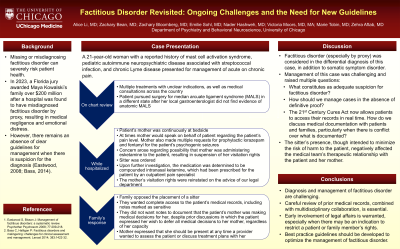Collaborative and Integrated Care
(057) Factitious Disorder Revisited: Ongoing Challenges and the Need for New Guidelines

- AL
Alice Li, MD
Resident Physician
University of Chicago Medical Center
Chicago, Illinois - ZB
Zachary Bean, MD (he/him/his)
Fellow
Northwestern Medicine
Chicago, Illinois 
Zachary Bloomberg, MD (he/him/his)
Adult Psychiatry Resident
University of Chicago
Chicago, Illinois
Emilie Sohl, MD
Physician Resident
University of Chicago
Chicago, Illinois
Nader Hashweh, MD
Psychiatry Resident
University of Chicago
Chicago, Illinois
Victoria Moors, MD, MA
PGY-1
University of Chicago Medical Center
Chicago, Illinois- MT
Marie B. Tobin, MD, FACLP
Professor
Chicago
Chicago, Illinois - ZA
Zehra Aftab, n/a
Psychiatrist
University of Chicago Medicine
Chicago, Illinois
Presenting Author(s)
Co-Author(s)
Background
Missing or misdiagnosing factitious disorder, whether imposed on self or others, can severely risk patient health. In 2023, a Florida jury awarded Maya Kowalski’s family over $200 million after a hospital was found to have misdiagnosed factitious disorder by proxy, resulting in medical negligence and emotional distress. However, there remains an absence of clear guidelines for management when there is suspicion for the diagnosis (Eastwood, 2008; Bass, 2014).
Case
A 21-year-old woman with a reported history of mast cell activation syndrome, pediatric autoimmune neuropsychiatric disease associated with streptococcal infection, and chronic Lyme disease presented for management of acute on chronic pain. She denied past psychiatric diagnoses. Chart review was notable for multiple treatments with unclear indications, as well as medical consultations across the country. For instance, the patient pursued surgery for median arcuate ligament syndrome (MALS) in a different state after her local gastroenterologist did not find evidence of anatomic MALS.
During the patient’s hospitalization, her mother was continuously at bedside. Concern arose that the mother was in possession of esketamine, resulting in suspension of her visitation rights. A sitter was ordered. However, further investigation showed that the medication was compounded intranasal ketamine, which had been prescribed for the patient by an outpatient pain specialist. The mother’s visitation rights were reinstated on the advice of our legal department.
Family opposed the placement of a sitter. They wanted complete access to the patient’s medical records, including notes marked as sensitive. Additionally, they did not want notes to document that the patient’s mother was making medical decisions for her. This is despite prior discussions in which the patient expressed her wish to defer all medical decisions to her mother, regardless of her capacity. Lastly, the family requested corrections to perceived inaccuracies in the patient’s records.
Discussion
Because the patient's medical history was concerning for excessive treatment seeking, and because of the possibility of the mother’s role in escalating care, factitious disorder was considered in the differential diagnosis, in addition to somatic symptom disorder. Management of this case was challenging. Legal affairs assisted in guiding decision making associated with the mother’s visitation rights. The sitter’s presence, though intended to minimize the risk of harm to the patient, negatively affected the medical team’s therapeutic relationship with the patient and her mother.
The 21st Century Cures Act adds a new layer of complexity to these types of cases by giving patients rapid access to their electronic health records. Patients with factitious disorder may attempt to control the findings and narratives recorded for future providers to see.
Conclusion
Diagnosis and management of factitious disorder are challenging. Early involvement of legal affairs is warranted when there may be an indication to restrict a patient or family member’s rights. Careful review of prior medical records, combined with multidisciplinary collaboration, is essential.
References
1. Eastwood S, Bisson J: Management of factitious disorders: a systematic review. Psychother Psychosom 2008; 77:209-218.
2. Bass C, Halligan P: Factitious disorders and malingering: challenges for clinical assessment and management. Lancet 2014; 383:1422-32.
Presentation Eligibility: Not previously published or presented
Diversity, Equity, and Inclusion: This case report illustrates ongoing challenges and the need for updated guidelines regarding the management of possible factitious disorder. We highlight the need for multidisciplinary collaboration in determining how to provide the most effective care for these patients. Specialties outside of psychiatry may be the first to observe signs of the disorder. Different patients may also require different approaches in management. As many of these cases are difficult to diagnose and treat, a diversity of perspectives will be essential to providing effective and compassionate care.

